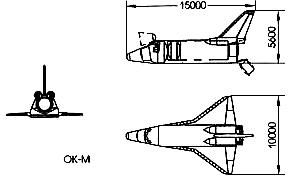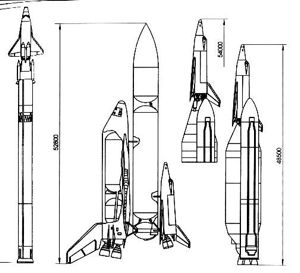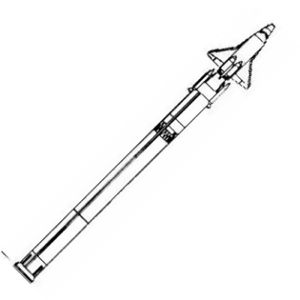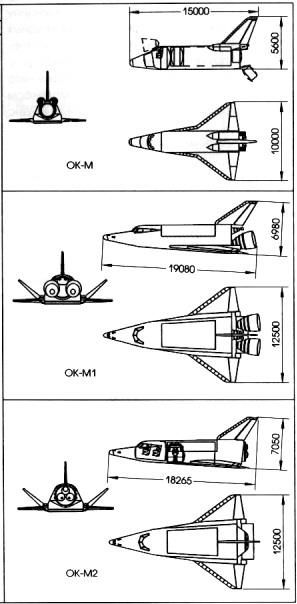
Home - Search - Browse - Alphabetic Index: 0- 1- 2- 3- 4- 5- 6- 7- 8- 9
A- B- C- D- E- F- G- H- I- J- K- L- M- N- O- P- Q- R- S- T- U- V- W- X- Y- Z
OK-M
 OKM Spaceplane |
Status: Study 1984. Payload: 3,500 kg (7,700 lb). Thrust: 7.84 kN (1,763 lbf). Gross mass: 15,000 kg (33,000 lb). Unfuelled mass: 13,200 kg (29,100 lb). Height: 15.00 m (49.00 ft). Span: 10.00 m (32.00 ft).
The OK-M was designed to be launched by the Zenit launch vehicle, using the double delta planform of the Buran.
In the 1980's NPO Energia and OKB Molniya studied designs of spaceplanes smaller than Buran to replace Soyuz and Progress spacecraft for space station crew rotation/replenishment tasks. Molniya favored an air-launched solution (see MAKS) while Energia favored conventional rocket launch. The earliest design, the OK-M, was designed to be launched by the Zenit launch vehicle. The aerodynamic scheme and double-delta planform of the OK-M was derived from Buran. A notable difference was a unitary fuselage (no cargo bay doors - payloads were extracted through a hatch at the rear). The crew cabin was not connected to the payload bay. After entering orbit the nose of the spaceplane hinged up to reveal an androgynous docking mechanism and crew hatch. in which the crew docked with the station through an androgynous docking apparatus. The thermal protection system would use the tiles and carbon-carbon nose cap material developed for Buran. The engine, guidance, and control systems were derived from those developed for the Soyuz-TM. Two 400 kg main engines were supplemented by a reaction control system of 26 x 50 kgf and 8 x 5 kgf thrusters. These were all housed in two gondolas positioned on either side of the vertical stabilizer (leaving the base free for the payload hatch). In orbit a 25 square meter solar panel would be deployed, supplementing 16 batteries of 1000 A-hours capacity, delivering a maximum of 2.5 kW.
The OK-M had a payload bay 2.2 m in diameter and 7 m long, with a total volume of 20 cubic meters. Normal crew was a two. Up to four additional passengers could be transported if required in a special module in the cargo bay. Landing mass of the OK-M without payload was 10,200 kg. With a crew of two the OK-M1 could deliver 3500 kg of payload to a 250 km orbit. However payload delivered to a 450 km space station orbit was limited to 2000 kg.
Total booster mass at lift-off with the OK-M was 400 metric tons. The OK-M was mated to the Zenit by a monocoque transition section, on which four solid abort motors of 25 metric tons thrust each were fitted. These would push the spaceplane away from the Zenit in the case of a first stage launch failure. At second stage ignition, they were ignited to provide an extra boost. The Zenit inserted the spaceplane into a 120 km altitude orbit at 51 degrees inclination. The OK-M used its own engines to maneuver into a higher orbit.
The low net payload the OK-M could deliver to a space station was considered unacceptable. Therefore NPO Molniya developed the OK-M1 and OK-M2 designs. These used other launch vehicles (the MMKS or Energia-M) and were over twice the size of the OK-M.
Crew Size: 6.
Family: Space station orbit, Spaceplane. Country: Russia. Launch Vehicles: Zenit-2. Propellants: N2O4/UDMH. Agency: Molniya bureau. Bibliography: 89.
 | OKM Boosters |
 | OKM Booster |
 | OKM Designs |
Back to top of page
Home - Search - Browse - Alphabetic Index: 0- 1- 2- 3- 4- 5- 6- 7- 8- 9
A- B- C- D- E- F- G- H- I- J- K- L- M- N- O- P- Q- R- S- T- U- V- W- X- Y- Z
© 1997-2019 Mark Wade - Contact
© / Conditions for Use